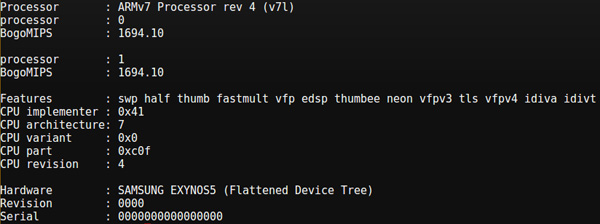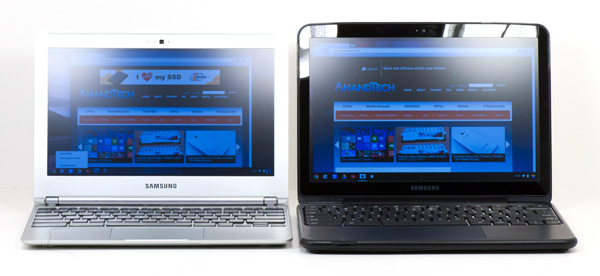Samsung Chromebook (XE303) Review: Testing ARM's Cortex A15
by Anand Lal Shimpi on October 31, 2012 9:00 AM ESTPerformance: Atom vs. ARM's Cortex A15
In our iPhone 5 review I included this crude diagram comparing the high level micro-architecture layouts of the current crop of mobile CPU cores. While most of the cores looked fairly similar, the one to really stand out is ARM's Cortex A15. A three issue, OoO core, the Cortex A15 was designed to put ARM in a completely new performance category.

For 2013, the Cortex A15 is expected to be the ARM CPU core of choice for the next wave of smartphone and tablet SoCs. NVIDIA's Wayne should integrate multiple Cortex A15s as well as competing solutions from Samsung and TI. Samsung's Exynos 5 Dual, found in the new Chromebook, integrates two ARM Cortex A15 cores running at 1.7GHz. As our first experience with a Cortex A15, I wanted to get a good idea for how it would compare to Intel's Atom. And now me comparing to the older Chromebook 500 makes sense. The Atom N570 in the older Chromebook is the closest approximation we have to the currently shipping Atom based mobile SoCs. There are a number of enhancements to the newer chips (particularly when it comes to power consumption), but the base core is very similar. It's clear that the Sandy Bridge Celeron based Chromebook is faster than this new Cortex A15 design, but how about the old dual-core Atom model?

As Chrome OS is built around the Chrome browser, our tests had to be largely JavaScript based unfortunately. The good news is that even given the nature of the benchmarks, we're able to get a good feel for performance between the two SoC platforms. Both systems were running the latest version of Chrome OS at the time of publishing.
| Samsung Chromebook Performance Comparison | ||||||
| SunSpider 0.9.1 | BrowserMark | RIABench Focus Tests | Kraken | |||
| Atom N570 1.66GHz | 1034.3 ms | 152780 | 1968 ms | 14229.5 ms | ||
| Exynos 5 Dual 1.7GHz | 690.5 ms | 217031 | 1192 ms | 9733.2 ms | ||
The Cortex A15 is fast. Across the board we're seeing a 40 - 65% increase in performance over a dual-core Atom. Although it's not clear how performance will be impacted as companies work to stick Cortex A15 based SoCs in smartphones with tighter power/thermal budgets, in notebooks (and perhaps even tablets) the Cortex A15 looks capable of delivering a good 1 - 2 generation boost over Intel's original Atom core.
The IE10 browser tests tend to agree with our JavaScript performance tests, although the CSS Maze Solver benchmark shows a huge advantage for ARM over Intel's Atom here.
| Samsung Chromebook Performance Comparison | ||||||
| IE10 Bubbles Test | IE10 Fishbowl | IE10 Maze Solver | ||||
| Atom N570 1.66GHz | 11 fps | 5 fps | 45 seconds | |||
| Exynos 5 Dual 1.7GHz | 17 fps | 8 fps | 17 seconds | |||
GPU performance is an even bigger advantage for the Exynos 5 Dual over Intel's old Atom N570 (GMA-3150 GPU). I ran three different webGL tests, each of which showed just how bad the old Atom GPU core was.
| Samsung Chromebook GPU Performance Comparison | ||||||
| WebGL Solar System | WebGL Cubes (500) | WebGL Aquarium (50) | ||||
| Atom N570 1.66GHz | 2 fps | 10 fps | 2 fps | |||
| Exynos 5 Dual 1.7GHz | 22 fps | 28 fps | 38 fps | |||
This comparison isn't really all that fair as the newer Atom cores use Imagination GPUs, although even then they are using relatively underpowered solutions compared to what Samsung is shipping on the Exynos 5 Dual.
The more relevant conclusions here apply to the CPU comparison. Next year Intel is expected to introduce its first new Atom core since the platform's introduction five years ago. The new architecture will bring an Out of Order execution core as well as a tangible performance increase. The question is whether or not this will be enough to fend off advances from Cortex A15 based designs.

The new Chromebook (left) vs. the old Atom based Chromebook (right)
In our Surface review I looked at Clovertrail Windows 8 tablet performance and put it a good 40%+ faster than NVIDIA's Tegra 3. If ARM's Cortex A15 is able to outperform Clovertrail by a similar margin, it could make the next generation of Windows RT tablets even more attractive. Keep in mind that we're looking at an older Atom platform here and not Clovertrail, so the performance deltas could shrink a bit.











149 Comments
View All Comments
iwod - Thursday, November 1, 2012 - link
Both Atom and Sandy /Ivy Bridge uses 4 thread compared to 2 threads the Cortex A15 uses. A better comparison would be a Quad Core A15. Which free the Core from doing other work in a Single Threaded Benchmarks and better illustrate mutithreaded performance.The A50 will offer 20 - 30% performance increase compared to A15 at 32 bit and further improvement at 64bit mode. This, with higher frequency and Quad Core or Hex Core will surely bridge the gap between everyday Laptop and a Chromebook.
Krysto - Thursday, November 1, 2012 - link
It doesn't matter. HT is pretty gimmicky anyway. You can maybe 10% improvement in performance.Don't forget A57 will not just have better IPC than A15, but will also go to higher clock speeds - up to 3 Ghz, actually. A quad core A57 chip at 3 Ghz will be more than enough performance for most people, while having very good battery life.
nishantmohan - Thursday, November 1, 2012 - link
"Plugging the Chromebook into a relatively modern (~2 year old) Samsung LED backlit LCD HTDV caused the Chromebook to reboot itself."i dont know why but I burst into laughter when i saw this....
legoman666 - Thursday, November 1, 2012 - link
Any word on the ship date for the 3g version? I preordered one on Amazon on the 19th, no word on ship date and I can't find one mentioned anywhere.TrackSmart - Thursday, November 1, 2012 - link
I opened this page and got taken here: http://testables.net/d/juicyru.comI'm guessing this is not what you guys agreed to regarding what advertisements on your site can do. Here's the brilliant message you get:
CONGRATULATIONS!
You've been selected from the [MY STATE] region to take part in our annual visitor survey.
This will only take 30 seconds of your time and will enhance user experience. Upon completion you will have the opportunity to get a iPad or iPad Mini, a $1000 Best Buy Card , or a $1,000 Visa Gift Card.
Mumrik - Friday, November 2, 2012 - link
"PC notebooks that still struggled with the same virus/malware issues they'd been facing for years"That comment had me confused. Is he talking about the crap companies put onto their non-business notebooks or did I miss some sort of virus/malware hell in 2010 that somehow later got solved?
yannigr - Friday, November 2, 2012 - link
This could be better, but it is okI have seen worst than this
What did you expect with so low price
This does not work but let's see something else that works
And here it is a USB 3.0 that works as a slow USB 2.0, and here it is a slot that it is not a slot but a hole
More or less this is what I was reading in this article. So you pay $249 and you buy a very light machine with overall poor quality and an OS that it is very limited in what you can do with it. And only 6 hour battery time?
Better buy a netbook, tablet or a second hand laptop for that price.
koss - Friday, November 2, 2012 - link
"Note that the previous Atom solution required two chips: the N570 and its NM10 Express PCH. The !!! -= N570 =- !!! had a 2.1W TDP and was used for all IO, while the N570 and its two Atom cores needed about 8.5W. "I guess that is the NM10 actually? Otherwise it makes no sense, to me at least.
I keep reading and loved the expression that "ARM is the new AMD", perhaps we should call them "ARMeD", since they are in the same boat now.
owned66 - Saturday, November 3, 2012 - link
put ubuntu on it = winruneks - Monday, November 5, 2012 - link
Anyone care to take a guess on how much this device would retail for if it included a battery with 50% or 100% more capacity? That would be a 45 or 60 Whr battery, respectively. I think it would fairly useful to be able to pull 9 hours from a single charge.